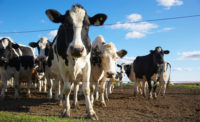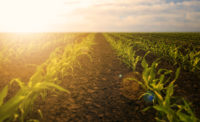An Agricultural Research Service (ARS)-led team completed a comprehensive life-cycle analysis quantifying the resource use and various environmental emissions of beef cattle production in the United States. The aim is to establish baseline measures that the U.S. beef industry can use to explore ways of reducing its environmental footprint and improving sustainability.
“The environmental footprint of producing beef has long been debated. One challenge is that the impacts extend beyond just those associated with growing the animals and include the impact of producing feed and other inputs. This is further complicated by the diversity of ways that beef cattle are managed and fed,” says Marlen Eve, deputy administrator for natural resources and sustainable agricultural systems for the Beltsville, Md., research agency. “It is important to have an accurate quantification of these impacts to provide a baseline against which production system sustainability can be assessed and improved.”
Led by ARS agricultural engineer Alan Rotz and conducted with ARS’ Pasture Systems and Watershed Management Research Unit in University Park, Pa., the team’s analysis encompassed an array of different types of cattle operations, reflecting a beef supply chain that’s among the most complex food production systems in the world. The scope of the analysis spanned five years, seven cattle-producing regions and used data from 2,270 survey responses and site visits nationwide. This ensured the results weren’t limited to a single region, where climate, soil, production practices and other factors can differ from other parts of the country.
Among the results to emerge thus far:
- The seven regions’ combined beef cattle production accounted for 3.3% of all U.S. greenhouse gas (GHG) emissions. By comparison, transportation and electricity generation together made up 56% of the total in 2016 and agriculture in general 9%.
- Fossil energy (for example, fuel) use in cattle production accounted for less than 1% of the total consumed nationally.
- Cattle only consumed 2.6 pounds of grain per pound of beef cut weight (or butchered carcass weight), which was comparable to pork and poultry.
- Beef operations in the Northwest and Southern Plains had the highest total water use (60% combined) of the seven regions analyzed. Irrigating crops to produce feed for cattle accounted for 96% of total water use across all the regions.
“We found that the greenhouse gas emissions in our analysis were not all that different from what other credible studies had shown and were not a significant contributor to long-term global warming,” Rotz says.
Two areas for potential improvement are water use and reactive nitrogen losses. Water use is increased in the West where U.S. beef cattle are concentrated. Reactive nitrogen losses (at 1.4 teragrams or 15% of the U.S. total) mainly in the form of ammonia can lead to smog, acid rain and algal blooms, for example, and potentially pose a public health concern.
The purpose of the analysis wasn’t to identify the top-performing regions or most efficient types of operations, but rather to systematically measure the use of fuel, feed, forage, electricity, water, fertilizer and other inputs to raise beef cattle throughout the country—from birth to slaughter.
Using a computer program called the “Integrated Farm System Model” (IFSM), the ARS team also estimated net releases of reactive forms of nitrogen such as ammonia from manure and urine, as well as the three major GHG (methane, carbon dioxide and nitrous oxide).
In the next six months, the team will combine the results of its IFSM analysis with post-harvest data from other sectors of the beef supply chain—namely processing, packing, distribution, retail, consumption and waste handling. That phase will be accomplished using the open-source life-cycle assessment program “OpenLCA.”
Together, these data will be used to generate a national assessment of the beef industry’s resource use, economics, net losses of GHG and other emissions, providing a critical tool for sustainably producing beef as an important source of lean protein and nutrients.



